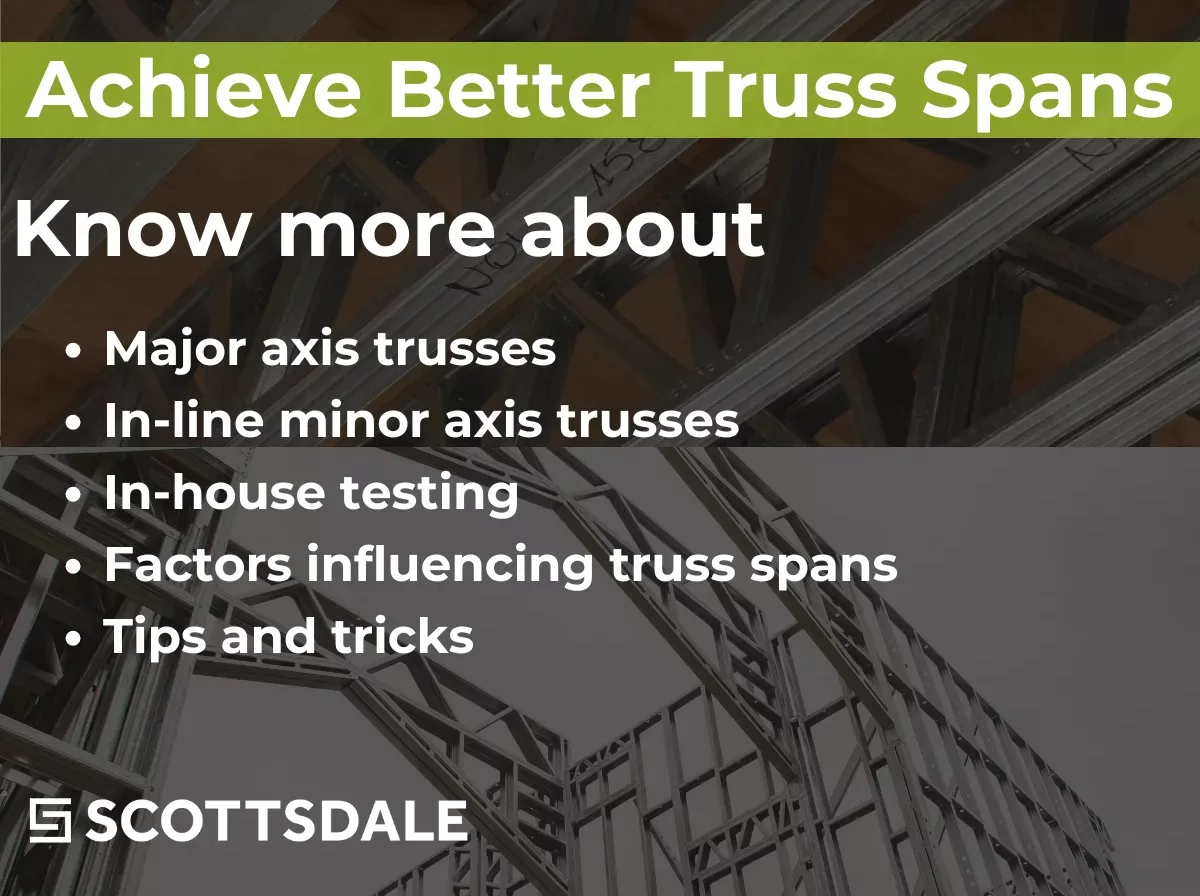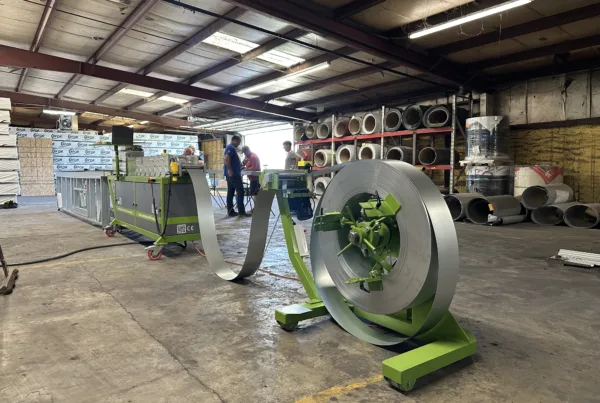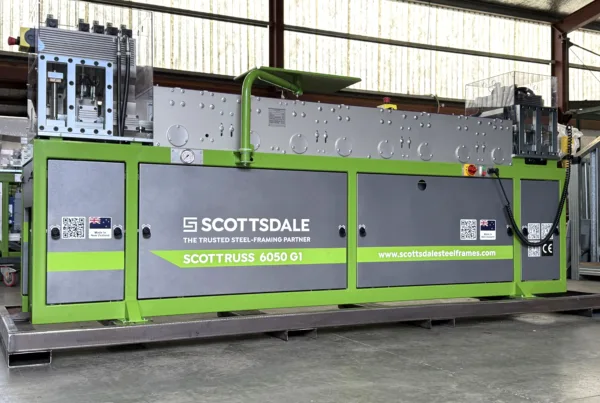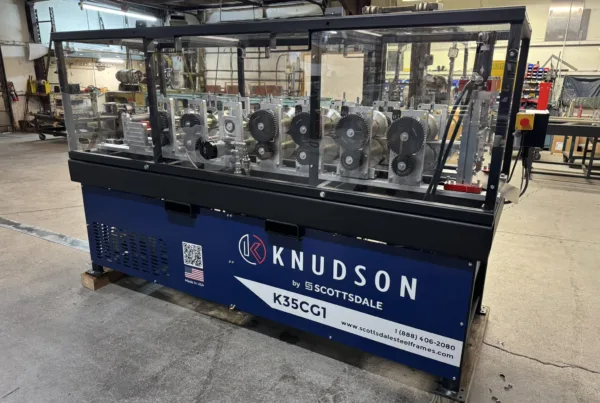Cold-formed steel trusses are structural frameworks made up of triangular units connected at joints, used to support roofs, bridges, and other structures. Their triangular design ensures even load distribution, providing stability and strength while minimizing material usage. This efficiency allows for greater spans without intermediate supports, reducing material costs and construction time. Additionally, trusses are versatile and adaptable to various architectural styles, making them a popular choice in modern construction projects.
Jump to Section
- Introduction to cold-formed steel trusses
- Shapes and profiles used in cold-formed steel trusses
- Factors influencing cold-formed steel truss spans
- Tips and tricks to achieve longer truss spans
- How to use these cold-formed steel trusses in your next project
Introduction to Cold-Formed Steel Trusses
Cold-formed steel trusses are making its significance in different sectors of the construction industry. This is attributed to the ease of design, fabrication and erection of these trusses in any construction project. These cold-formed steel trusses are used predominantly as roof and floor supporting structures in the residential and commercial sectors. They are also used as portal trusses to act as bracing elements within the building where traditional strap and K-braces doesn’t provide adequate lateral resistance.
Image below shows typical application of cold-formed steel trusses from prestigious Scottsdale customers. For more insightful projects, refer to the project gallery. Click here to view more projects.
SHAPES AND Profiles Used in Cold-Formed Steel Trusses
Cold-formed steel trusses are versatile and can be made to create virtually any roof shape. Typically roof shapes are governed by the architectural plans but can be customized to any shape depending upon the end user needs. These roof shapes include monoslope, dual pitch, scissor, stepped, curved etc. The versatility of cold-formed steel with the help if cutting edge design and engineering software such as ScotSteel, users can model these truss shapes with ease.
Some of the commonly used truss shapes in the construction industry are shown below in 3D viewer.
Cold-Formed Steel – Truss Types by Scottsdale Construction Systems on Sketchfab
Image below shows 2D elevation view of the most commonly used trusses.
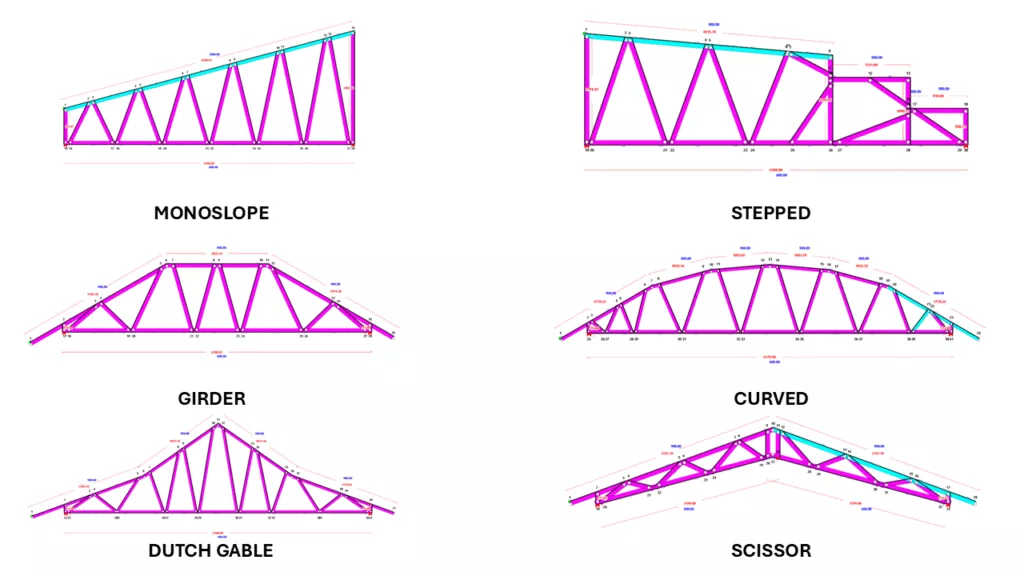
With the versatility of cold-formed steel, the help of our cutting-edge roll forming machines (Scottruss, Scotpanel, and KFS Framemaker), and our design/engineering software (ScotSteel and ScotStruct) our customers can model and fabricate six different types of steel trusses with ease. These truss types include:
1. Inline trusses,
2. Stiffened-chord in-line trusses,
3. Back-to-back (strong-axis) trusses,
4. Box-section reinforced inline trusses,
5. Double-chord cluster trusses, and
6. Box-section reinforced back-to-back (strong-axis) trusses.
Different section profiles are generally used in creation of these trusses. The truss shapes and associated connection determine the span of these trusses in real world applications. The section profiles can be broadly classified into two types depending upon the axis of orientation of the truss members. These include major and minor axis trusses.
Major axis trusses are those in which the top and bottom chord members of the trusses are oriented about the major principal axis (strong axis) of the section profile. Whereas, minor axis trusses are those in which the top and bottom chord members are oriented about the minor principal axis (weak axis). The orientation of the trusses are dependent entirely on the capacity of the machines to produce the corresponding trusses. The image below details the commonly used major and minor axis truss profiles.
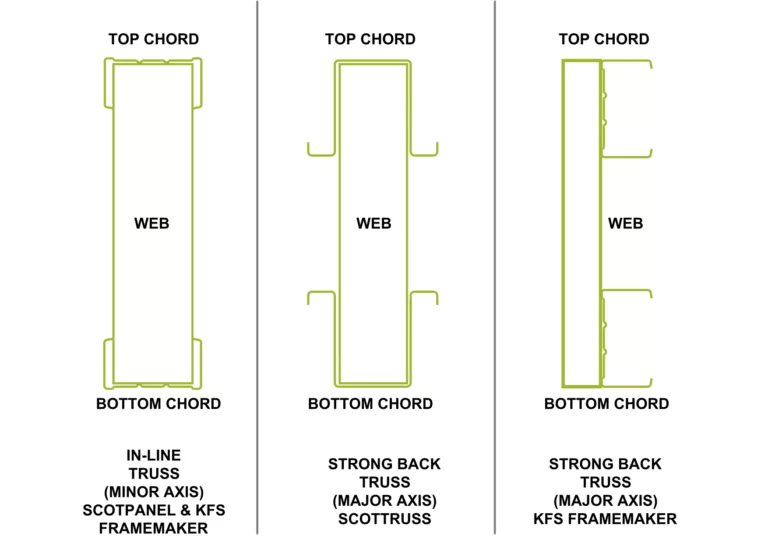
Scotpanel roll former can produce the in-line trusses using C-sections while the Scottruss roll former can produce the strong back (major axis truss) using hat sections. The KFS Framemaker roll formers can produce both in-line and strong back trusses using C-sections.
Factors influencing cold-formed steel truss spans
Cold-formed steel truss spans depend on a wide variety of factors, each playing a critical role in the design and performance of the structure. The main factors are detailed below:
Loads
First and foremost, the truss must resist a combination of loads, including:
-
Dead loads from roofing and flooring materials,
-
Live loads from occupants, equipment, and other movable objects during the building’s service life,
-
Wind, snow, and rain loads based on geographic location and climatic conditions.
Since load intensity varies by project type and user requirements, accurate load assessment remains essential. Loads ultimately serve as the primary driver in determining the maximum achievable truss span.
It is worthwhile to understand the appropriate reduction factors specified in the codes for your project to achieve greater truss spans.
Effective Lengths
Next, the effective length of truss members greatly influences their strength. Longer effective lengths tend to increase the risk of buckling, which reduces the overall load-carrying capacity. Providing sufficient lateral bracing and optimizing member layout help reduce effective lengths and improve structural stability. Lateral bracings in trusses are provided through battens depending upon the application. Battens are screwed to the top and bottom chords of the trusses thereby reducing the effective length and also providing necessary out-of-plane restraints. Image below shows roof trusses with ceiling battens installed.
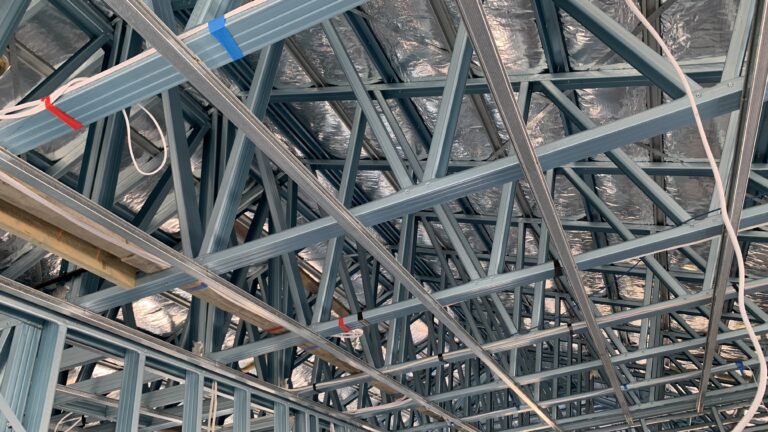
As an example, adding ceiling battens at 450 mm centers can reduce the effective length in out-of-plane direction of a 4-meter bottom chord by 88%. This will have a huge impact in strength calculation of the truss bottom chord members.
Connection Capacities
In addition, connection performance directly impacts the strength of the truss system. Properly designed bolted, riveted and screwed connections efficiently transfer forces between members without excessive deformation. In cold-formed steel trusses, connection strength often governs overall capacity more than member strength itself in some cases. To enhance the design capacities, thereby achieving the required spans, all connections used in the Scottsdale truss system are tested in-house to achieve maximum strength utilisation. In-house tested connection capacities provide over 20% more capacity than capacities predicted by equations from the standards. The image below shows a connection capacity test conducted in-house.
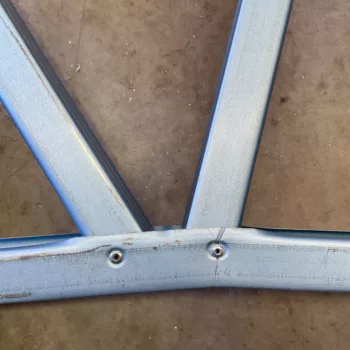
Steel Grade
Moreover, selecting the appropriate steel grade enhances the design capacities to use a greater yield and ultimate tensile strength within the engineering calculations. Higher-grade steels enable longer spans with lighter sections, improving structural efficiency. Conversely, lower-grade steels may require thicker or additional members to achieve comparable strength, potentially increasing material usage and cost. It is always a good practice to individually test the tensile capacity of the steel coil on top of the mill certificate received from the supplier. Image below shows tensile coupon tests on the steel used for trusses.
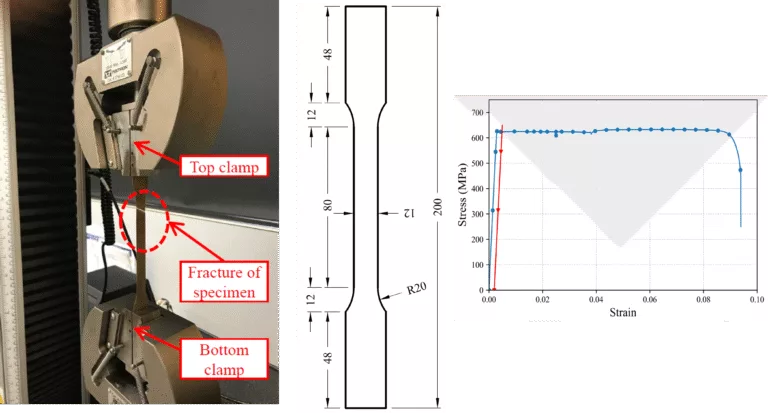
Profile Thickness
Similarly, profile thickness significantly affects the truss’s stiffness and load-carrying ability. Thicker profiles can support greater loads and span longer distances; however, they also add self-weight to the structure. Selecting the optimal profile thickness involves balancing steel grade strength, weight, and economy. More details about choosing the right thickness can be found in the attached article – A Practical Guide to Cold-Formed Steel Thickness
As a general guideline, if a truss fails engineering checks in Scotsteel under the default configuration but passes after adding more web members, resulting in a weight increase of over 20%, it is more efficient to retain the original webbing layout and instead upgrade to a higher material thickness. This approach also reduces labor costs by minimizing the number of connections between web and chord members.
Truss Depth
Finally, truss depth plays a major role in spanning capability. Deeper trusses reduce bending stresses in the chord members, allowing for longer spans with more efficient material use. However, increased depth can influence the building’s architectural layout and usable space, requiring careful optimization. For example, in the below image, a hat section truss from Scottruss rollformer passes for a 7-meter clear span while a C-section truss from Scotpanel rollformer fails the engineering checks. This is attributed to the excessive stresses developed in the top and bottom chord members for various section profiles.
Tips and tricks to achieve longer truss spans
The cold-formed steel truss spans can be increased through various methods depending upon the project needs. Some of the commonly used methods are detailed below.
Increasing the number of truss plies – This results in increasing the structural adequacy of the truss to either increase the spans OR carry more loads for the given spans and loaded widths. The image below shows a roof truss spanning 100 ft with 5 plies.
Using a composite connection capacity – There may be instances where the truss failure for the given span is governed by the connection capacity instead of the member capacity. In such cases, the connection between the chord and web members can govern. To overcome such situations and achieve the required spans, the connections can be strengthened using the addition of tek screws on top of rivets in case of C-section and Hat-section trusses. Gusset plates can also be introduced on the face of the trusses to strengthen the connection capacities. Image below shows typical truss strengthening options.
Using composite members – Member failures in trusses can also be strengthened by introducing additional members in areas where the failure occurs during the analysis and design phase. In such cases, more members can be stitched to the chord and web members using additional tek screws to act as a composite section during the design phase. This in turn increases the structural adequacy of the member and also can help in reducing the overall deflection. More details about truss strengthening can be found in the articles below.
- Strengthening of Hat section trusses under heavy loads – Scottsdale Steel Frames
- Enhancing Cee Section Trusses for Heavy Load Applications: Techniques and Innovations – Scottsdale Steel Frames
How to use cold-formed steel trusses in your next project
At Scottsdale, we are proud to drive innovation in the construction industry by revolutionizing traditional framing methods with cold-formed steel trusses. Many of our customers have successfully adopted cold-formed steel solutions, experiencing a smoother, faster, and more efficient building process compared to other materials available on the market.
If you’re considering using cold-formed steel trusses for your future projects, reach out to us at sales@scottsdalesteelframes.com, or call +1 (888) 406-2080 (Option 1) or +61 1300 671 345.
Our team of experts is ready to support you in setting up your own cold-formed steel manufacturing facility and ensuring a seamless transition to steel framing.
